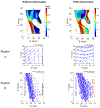The effects of upper airway tissue motion on airflow dynamics
- PMID: 31780123
- PMCID: PMC7324469
- DOI: 10.1016/j.jbiomech.2019.109506
The effects of upper airway tissue motion on airflow dynamics
Abstract
The human upper airway is not only geometrically complex, but it can also deform dynamically as a result of active muscle contraction and motility during respiration. How the active transformation of the airway geometry affects airflow dynamics during respiration is not well understood despite the importance of this knowledge towards improving current understanding of particle transport and deposition. In this study, particle imaging velocimetry (PIV) measurements of the fluid dynamics are presented in a physiologically realistic human upper airway replica for (i) the undeformed case and (ii) the case where realistic soft tissue motion during breathing is emulated. Results from this study show that extrathoracic wall motion alters the flow field significantly such that the fluid dynamics is distinctly different from the undeformed airway. Distinctive flow field patterns in the physiologically realistic airway include (i) fluid recirculation at the back of the tongue and cranial to the tip of the epiglottis during mid-inspiration, (ii) horizontal and posteriorly directed flow at the back of tongue at the peak of inspiration and (iii) a more homogeneous flow across the airway downstream from the epiglottis. These findings suggest that the active deformation of the human upper airway may potentially influence particle transport and deposition at the back of the tongue and therefore, highlights the importance of considering extrathoracic wall motion in future airway flow studies. D.
Keywords: Drug delivery; Flow dynamics; Particle image velocimetry; Tissue motion; Upper airway.
Crown Copyright © 2019. Published by Elsevier Ltd. All rights reserved.
Figures





Similar articles
-
Assessing the relationship between movement and airflow in the upper airway using computational fluid dynamics with motion determined from magnetic resonance imaging.Clin Biomech (Bristol). 2019 Jun;66:88-96. doi: 10.1016/j.clinbiomech.2017.10.011. Epub 2017 Oct 14. Clin Biomech (Bristol). 2019. PMID: 29079097
-
Effects of respiratory rate on the fluid mechanics of a reconstructed upper airway.Med Eng Phys. 2022 Feb;100:103746. doi: 10.1016/j.medengphy.2021.103746. Epub 2021 Dec 23. Med Eng Phys. 2022. PMID: 35144732
-
Simulating the effect of individual upper airway anatomical features on drug deposition.Int J Pharm. 2022 Nov 25;628:122219. doi: 10.1016/j.ijpharm.2022.122219. Epub 2022 Sep 28. Int J Pharm. 2022. PMID: 36179925
-
A Review of Respiratory Anatomical Development, Air Flow Characterization and Particle Deposition.Int J Environ Res Public Health. 2020 Jan 7;17(2):380. doi: 10.3390/ijerph17020380. Int J Environ Res Public Health. 2020. PMID: 31935991 Free PMC article. Review.
-
Pediatric in vitro and in silico models of deposition via oral and nasal inhalation.J Aerosol Med Pulm Drug Deliv. 2014 Jun;27(3):149-69. doi: 10.1089/jamp.2013.1075. J Aerosol Med Pulm Drug Deliv. 2014. PMID: 24870701 Review.
Cited by
-
Numerical and Experimental Analysis of Inhalation Airflow Dynamics in a Human Pharyngeal Airway.Int J Environ Res Public Health. 2020 Feb 28;17(5):1556. doi: 10.3390/ijerph17051556. Int J Environ Res Public Health. 2020. PMID: 32121245 Free PMC article.
-
Methodological parameters for upper airway assessment by cone-beam computed tomography in adults with obstructive sleep apnea: a systematic review of the literature and meta-analysis.Sleep Breath. 2023 Mar;27(1):1-30. doi: 10.1007/s11325-022-02582-6. Epub 2022 Feb 21. Sleep Breath. 2023. PMID: 35190957 Free PMC article.
-
Growth-profile configuration for specific deformations of tubular organs: A study of growth-induced thinning and dilation of the human cervix.PLoS One. 2021 Aug 11;16(8):e0255895. doi: 10.1371/journal.pone.0255895. eCollection 2021. PLoS One. 2021. PMID: 34379659 Free PMC article.
References
-
- Bradley TD, Floras JS, 2003. Sleep Apnea and Heart Failure. Circulation 107, 1671–1678. - PubMed
-
- Cheng S, Butler JE, Gandevia SC, Bilston LE, 2010. Movement of the human upper airway during inspiration with and without inspiratory resistive loading. Journal of Applied Physiology 110, 69–75. - PubMed
-
- Cheng S, Fletcher D, Hemley S, Stoodley M, Bilston L, 2014b. Effects of fluid-structure interaction in a three dimensional model of the spinal subarachnoid space. Journal of Biomechanics 47, 2826–2830. - PubMed
Publication types
MeSH terms
Grants and funding
LinkOut - more resources
Full Text Sources

